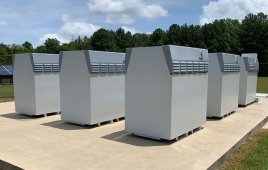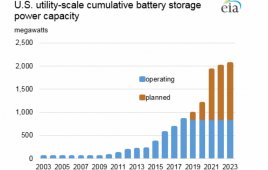The nation’s energy infrastructure will undergo a significant transformation over the next 10 years due in large measure to the emergence of cost-effective energy storage, according to a new study by Mortenson, a recognized North American leader in energy and transmission infrastructure. While it will require considerable regulatory changes, energy storage – and battery energy storage, in particular – is seen as a disruptive technology that will flourish and help transform how electrical power is generated, distributed, and consumed in the U.S.
The Rise & Future of Energy Storage study identifies strong optimism among industry insiders for energy storage and the tremendous benefits it can bring to the nation’s power grid. Nearly all professionals surveyed (ninety-six percent) believe that emerging energy storage technology is a major catalyst for important change in an industry primed for change, though they recognize that such transformation will not come easily. High percentages indicated the growth of electricity storage will require regulatory changes in order to achieve commercial viability.
California, New York and Texas are currently viewed as the states most supportive of electricity storage development over the next 5 to 7 years. Professionals predict energy storage will see its greatest advancement when paired with renewables and distributed generation, both of which they believe will continue to grow. Industry experts also see increased competition and an altered role for utilities in the future with eighty-nine percent stating that they believe the electric power industry will look and operate differently a decade from now.
Significant challenges still must be overcome according to the study. Storage costs must come down, viable business models must be developed and confirmed, and the regulatory environment must change to fairly reward storage providers. “We’re entering a period of rapid transformation for the U.S. energy industry,” said Brent Bergland, general manager at Mortenson. “While energy storage is not universally cost effective across the U.S. today, there will be this ‘quantum leap’ moment when technology costs drop and the regulatory environment and policies improve, and then the market just takes off. That moment has not yet arrived but it’s coming.” Global utility-scale, grid-connected battery storage is forecast to grow to 12 GW by 2024 according to a 2015 industry study. Driving this activity is increasing renewable energy generation and supportive policies and regulations, and growth of smart grids and energy infrastructure.
Mortenson spoke to 165 industry professionals at the Energy Storage Association Annual Conference and Expo. Sign-up to receive the full report at www.Mortenson.com/storage2016. A podcast on the topic is also available at http://www.mortenson.com/company/news-and-insights/bwn-energy-storage-studypodcast.
For more information: mortenson.com
Filed Under: Energy storage





